There’s a reason they call Christmas the most wonderful time of the year! Because it’s a great time to be an entrepreneur. Business andr ...
You might consider targeting a niche market by specializing in one type of tree.
We earn commissions if you shop through the links below. Read more
Written by: Carolyn Young
Carolyn Young is a business writer who focuses on entrepreneurial concepts and the business formation. She has over 25 years of experience in business roles, and has authored several entrepreneurship textbooks.
Edited by: David Lepeska
David has been writing and learning about business, finance and globalization for a quarter-century, starting with a small New York consulting firm in the 1990s.
Published on December 13, 2021

Investment range
$4,250 - $85,300
Revenue potential
$80,000 - $120,000 p.a.
Time to build
1 – 3 months
Profit potential
$76,000 - $114,000 p.a.
Industry trend
Growing
Commitment
Flexible
Here are the most important factors you should consider when starting a Christmas tree farm:
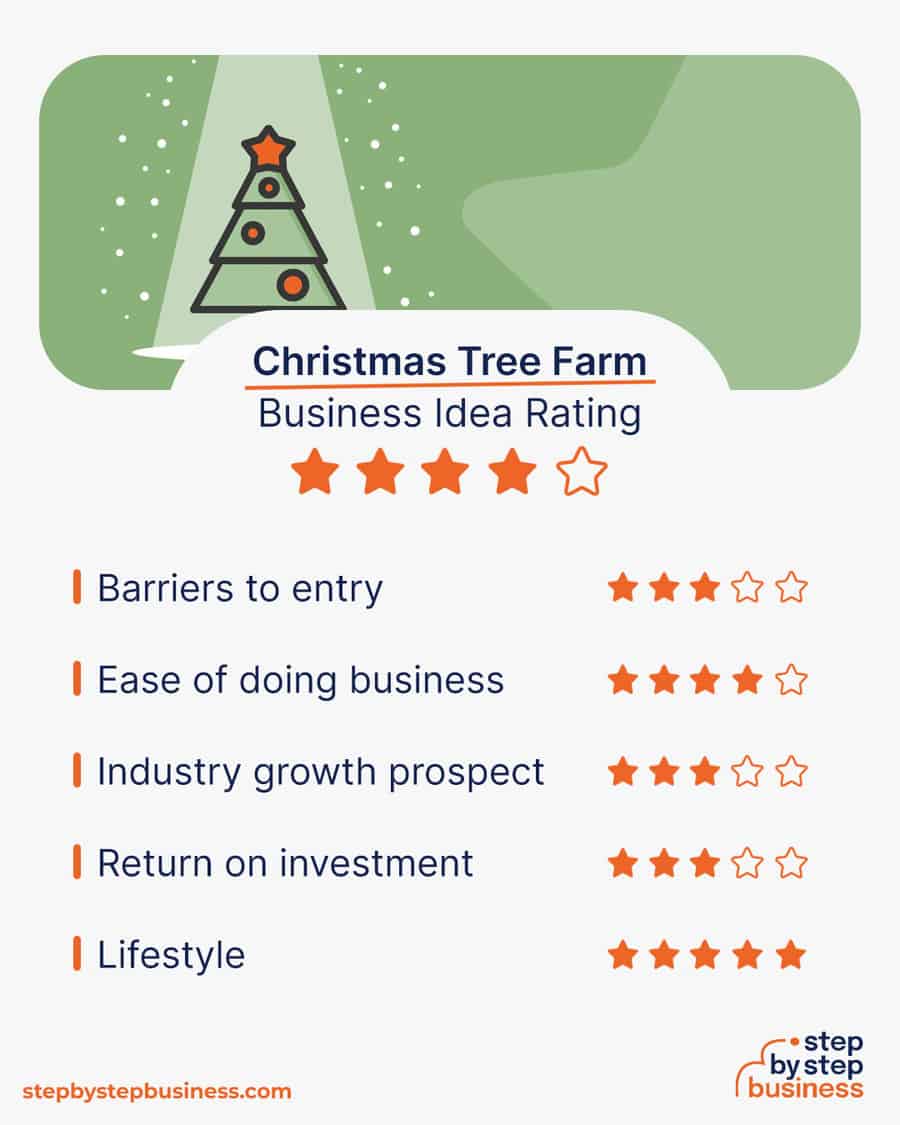
Every business has pros and cons, and they need to be carefully considered before you decide if a Christmas tree farm is right for you.
As many as 30 million Christmas trees are sold in the US each year, with about 350 million trees growing at any given time.((https://realchristmastrees.org/education/quick-tree-facts/))
Demand remains strong for real Christmas trees, yet supply is low due to supply chain issues and climate change.((https://www.cnbc.com/2021/11/16/christmas-tree-shortage-because-of-supply-chain-issues-climate-change.html)) This is good news for small Christmas tree farmers, giving them an advantage over the big stores like Lowe’s and Walmart, which rely on traditional supply chains. It’s also good news because it’s driving up prices by as much as 25%.
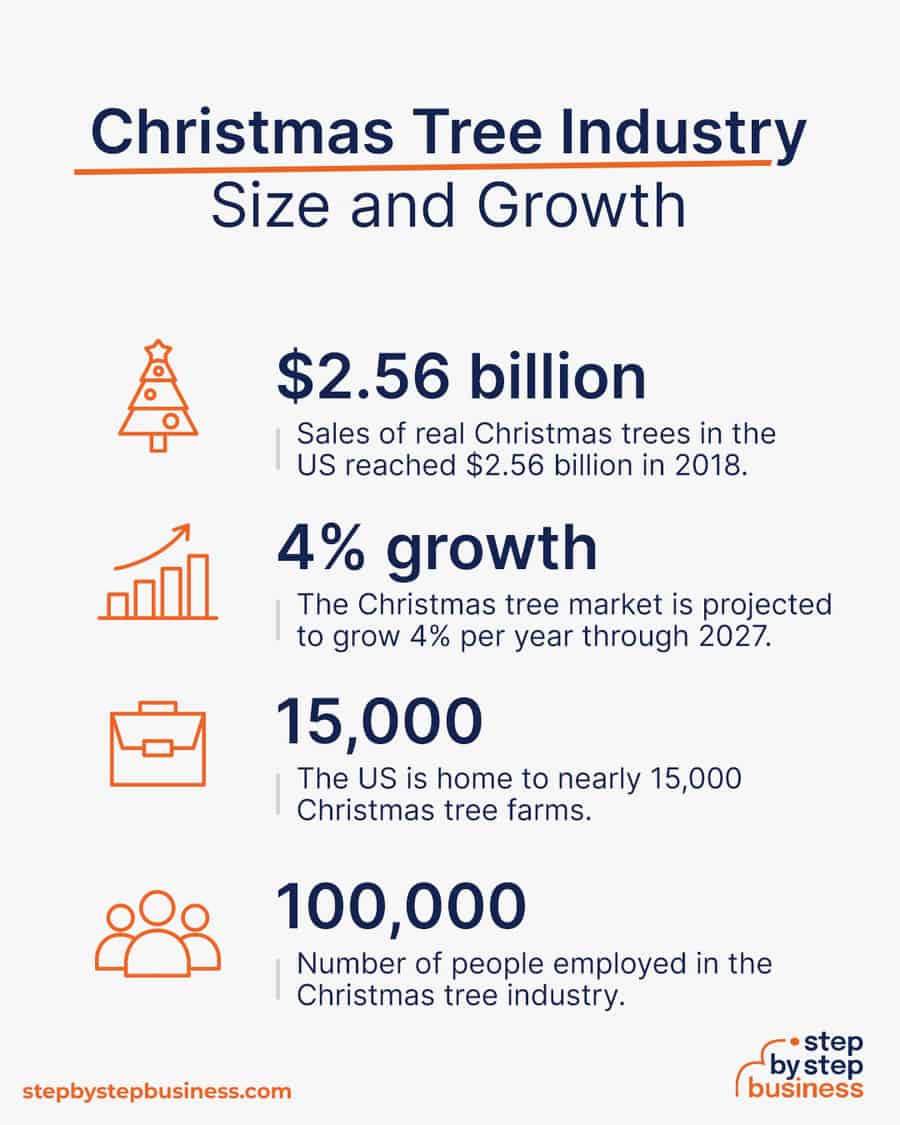
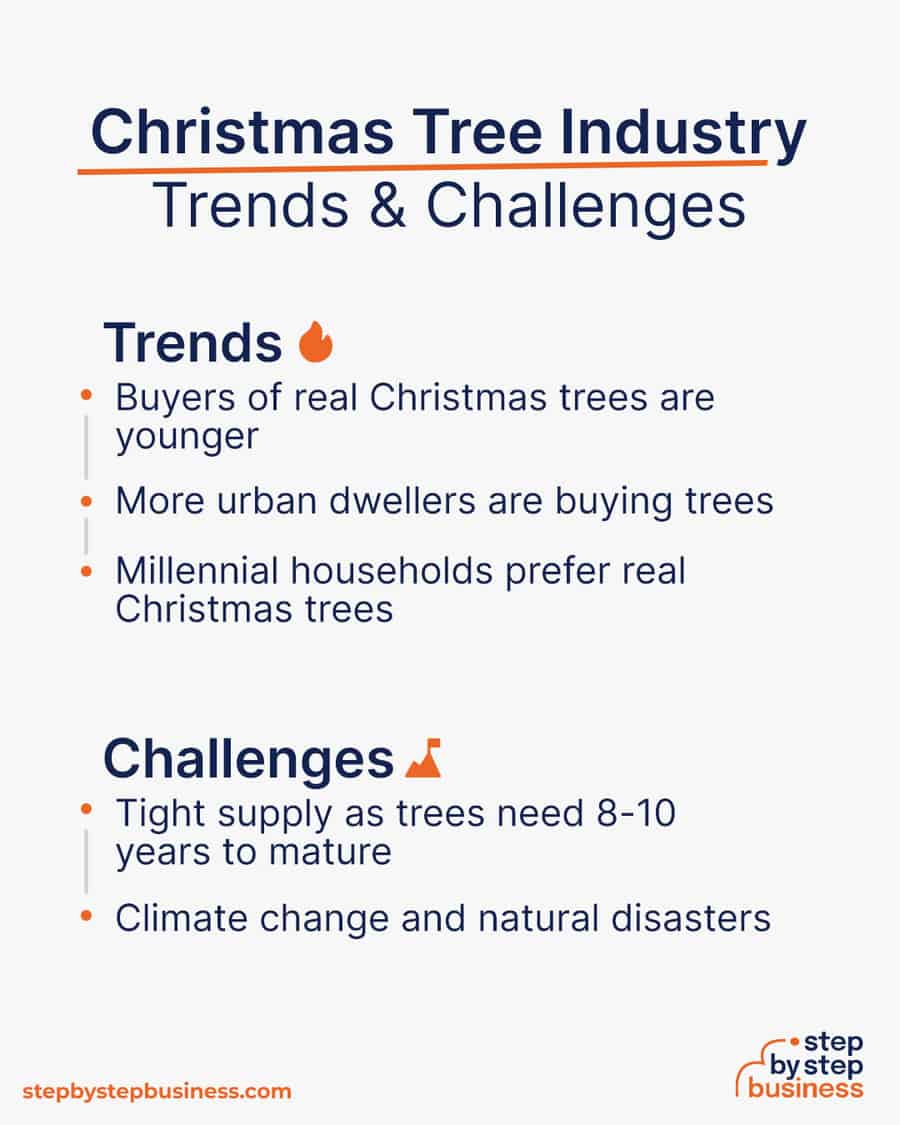
Trends
Challenges
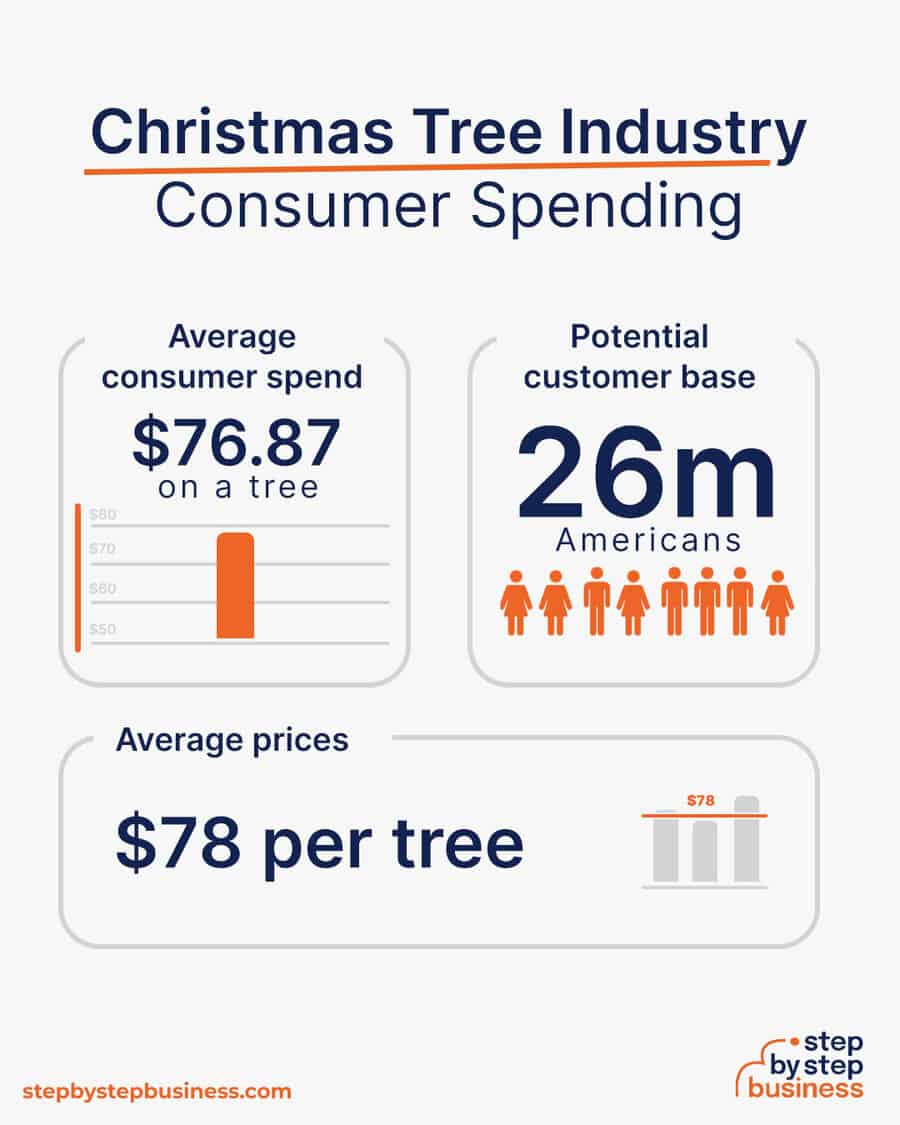
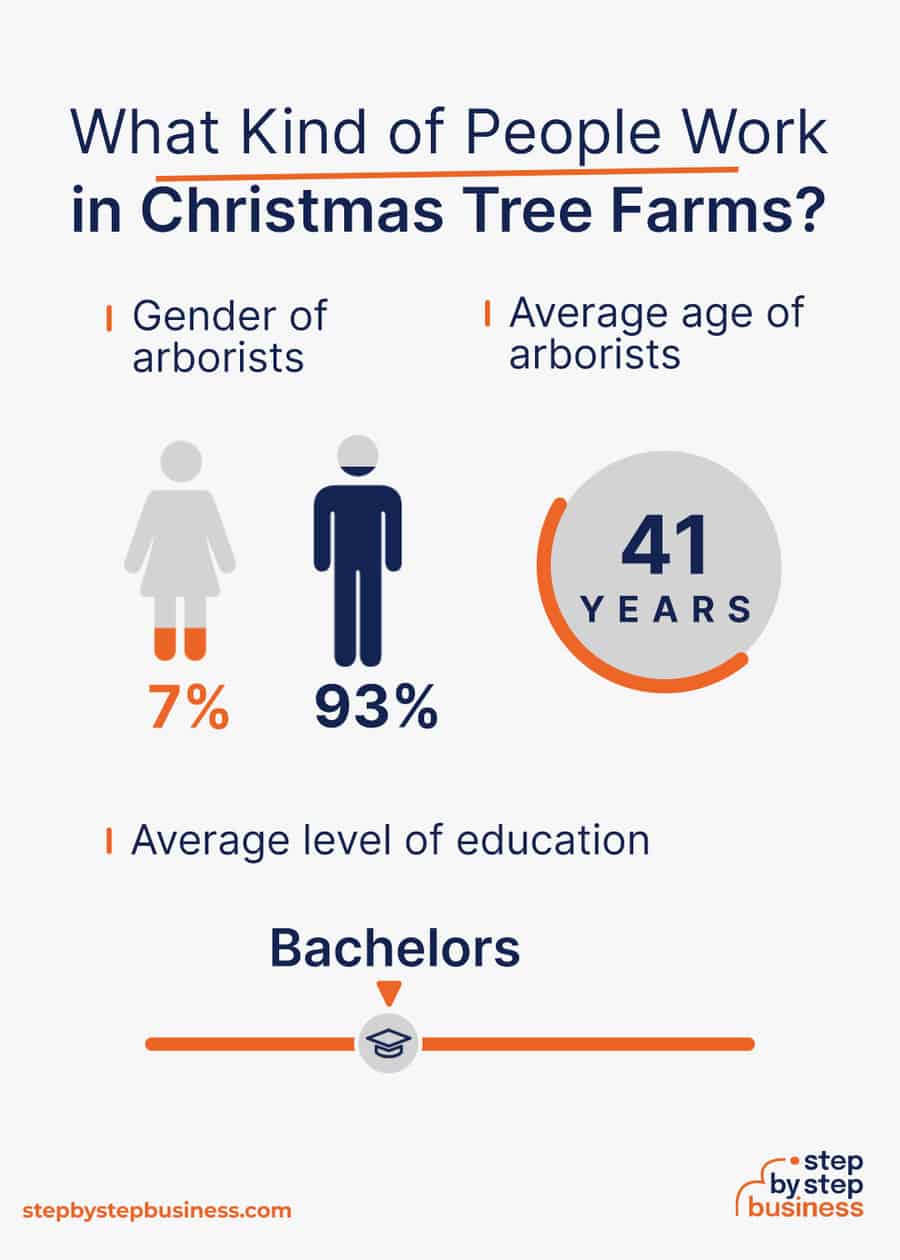
An arborist is a tree doctor who treats tree diseases and other problems.
Startup costs for a Christmas tree farm range from around $4,000 to $85,000. The high end includes purchasing land for your farm, so if you already own land, you’re ahead of the game.
If you don’t have land, you could potentially enter a sharecropping agreement with a landowner. That means that you would essentially be a tenant of the landowner, grow your trees, and split the income.
You’ll need a handful of items to launch your Christmas tree farm successfully. Here’s a list to help you get started:
| Startup Costs | Ballpark Range | Average |
|---|---|---|
| Setting up a business name and corporation | $150–$200 | $175 |
| Licenses and permits | $200–$300 | $250 |
| Insurance | $100–$300 | $200 |
| Business cards and brochures | $200–$300 | $250 |
| Website setup | $1,000–$3,000 | $2,000 |
| Down payment for land | $0–$75,000 | $37,500 |
| Equipment such as tractor | $2,000–$5,000 | $3,500 |
| Land preparation | $500–$1,000 | $750 |
| Seedlings | $100–$200 | $150 |
| Total | $4,250–$85,300 | $44,775 |
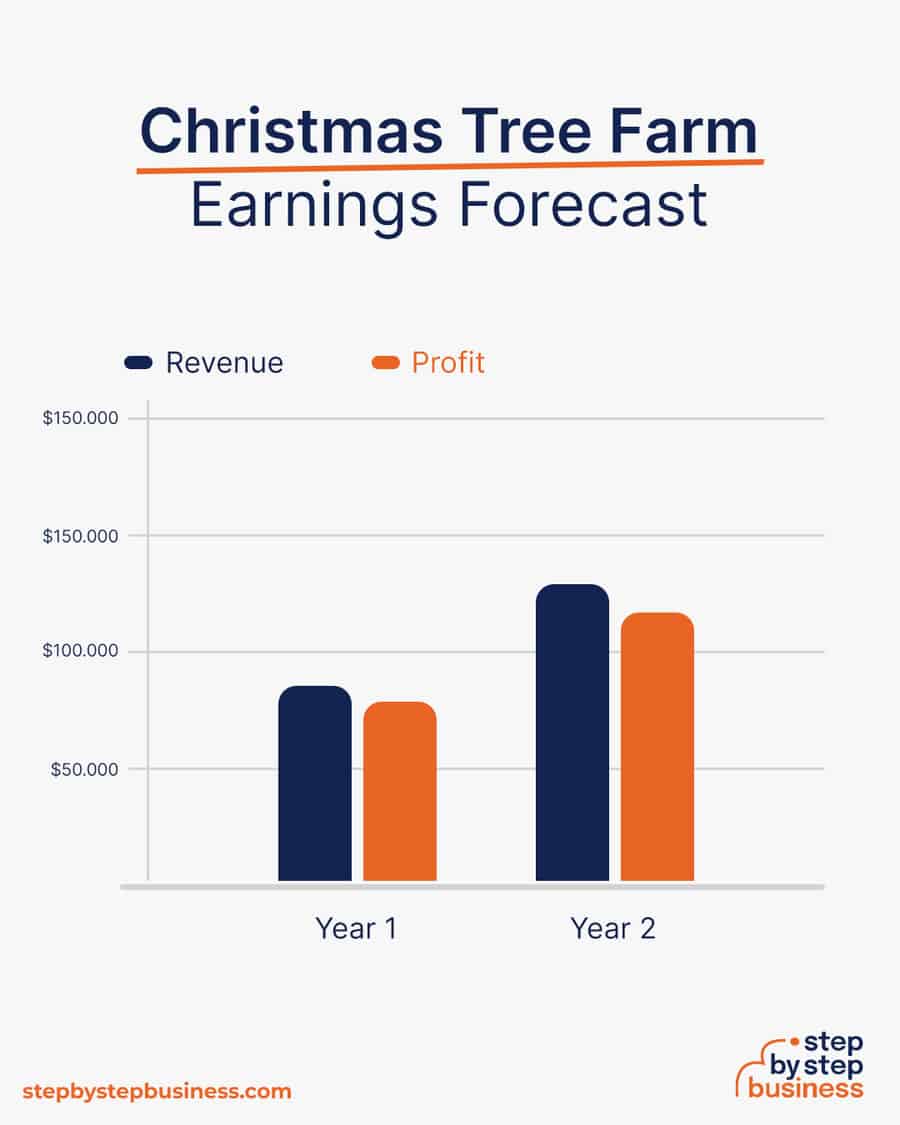
Setting aside the cost of farmland, the cost to grow a single tree is about $1, while the same tree can be sold for about $80, resulting in a more than 95% profit margin.
With 10 acres, after 8–10 years, you could produce 1,000 trees. Assuming they all sell, you would bring in $80,000 in annual revenue and $76,000 in profit. As your brand gains recognition, you could add acreage, and sales could climb to 1,500 trees a year. With an expected annual revenue of $120,000, you would make about $114,000.
There are a few barriers to entry for a Christmas tree farm. Your biggest challenges will be:
Now that you know what’s involved in starting a Christmas tree farm, it’s a good idea to hone your concept in preparation to enter a competitive market.
Market research will give you the upper hand, even if you’re already positive that you have a perfect product or service. Conducting market research is important because it can help you understand your customers better, who your competitors are, and your business landscape.
Research your area for Christmas tree farms and identify which types of Christmas trees are most popular. Right now, in many areas, the most popular types are firs and blue spruce. You’ll need to find out which trees grow best in the climate and soil type of your area and then determine what trees you want to grow.
You might consider targeting a niche market by specializing in one type of tree.
This could jumpstart your word-of-mouth marketing and attract clients right away.
In addition to trees, you could increase your revenue by selling other items. If you have enough land, you could even grow other types of trees and plants so that your business is less seasonal. Additional products might include:
The cost of a live Christmas tree is around $80. Your costs of growing and selling your trees should be very low, so your profit margin will be quite high.
Once you know your costs, you can use our profit margin calculator to determine your mark up and final price points. Remember, the prices you use at launch should be subject to change if warranted by the market.
Your target market will be broad, but it will mainly be families who celebrate Christmas. You’re more likely to reach families on a site like Facebook rather than on Instagram.
Here are the factors to consider when selecting the ideal location for a Christmas tree farm:
If your farm is in a location that’s convenient for a lot of people, you won’t need a commercial space. If you are in a more rural area, you may need to rent out part of a parking lot or other outdoor space for your stand. You can find commercial space to rent in your area on Craigslist, Crexi, and Commercial Cafe.
Here are some ideas for brainstorming your business name:
Discover over 340 unique Christmas tree farm name ideas here. If you want your business name to include specific keywords, you can also use our Christmas tree farm business name generator. Just type in a few keywords, hit Generate, and you’ll have dozens of suggestions at your fingertips.
Once you’ve got a list of potential names, visit the US Patent and Trademark Office website to make sure those names are available for registration below. Check the availability of related domain names using our Domain Name Search tool. Using “.com” or “.org” sharply increases credibility, so it’s best to focus on these.
Finally, make your choice among the names that pass this screening and go ahead with domain registration and social media account creation. Your business name is one of the key differentiators that set your business apart. Once you pick your company name and start with the branding, it is hard to change the business name. Therefore, it’s important to carefully consider your choice before you start a business entity.
Here are the key components of a business plan:

If you’ve never created a business plan, it can be an intimidating task. You might consider hiring a business plan specialist to create a top-notch business plan for you.
Registering your business is an absolutely crucial step — it’s the prerequisite to paying taxes, raising capital, opening a bank account, and other guideposts on the road to getting a business up and running.
Plus, registration is exciting because it makes the entire process official. Once it’s complete, you’ll have your own business!
Your business location is important because it can affect taxes, legal requirements, and revenue. Most people will register their business in the state where they live, but if you are planning to expand, you might consider looking elsewhere, as some states could offer real advantages when it comes to Christmas tree farms.
If you’re willing to move, you could really maximize your business! Keep in mind that it’s relatively easy to transfer your business to another state.
Business entities come in several varieties, each with its pros and cons. The legal structure you choose for your Christmas tree farm will shape your taxes, personal liability, and business registration requirements, so choose wisely.
Here are the main options:

We recommend that new business owners choose LLC as it offers liability protection and pass-through taxation while being simpler to form than a corporation. You can form an LLC in as little as five minutes using an online LLC formation service. They will check that your business name is available before filing, submit your articles of organization, and answer any questions you might have.
Choose Your State
The final step before you’re able to pay taxes is getting an Employer Identification Number or EIN. You can file for your EIN online or by mail/fax. Visit the IRS website to learn more. Keep in mind, if you’ve chosen to be a sole proprietorship, you can simply use your social security number as your EIN.
Once you have your EIN, you’ll need to choose your tax year. Financially speaking, your business will operate in a calendar year (January–December) or a fiscal year, a 12-month period that can start in any month. This will determine your tax cycle, while your business structure will determine which taxes you’ll pay.
The IRS website also offers a tax-payers checklist, and taxes can be filed online.
It is important to consult an accountant or other professional to help you with your taxes to ensure you are completing them correctly.
Securing financing is your next step, and there are plenty of ways to raise capital:

Bank and SBA loans are probably the best options, other than friends and family, for funding a Christmas tree farm. You might also try crowdfunding if you have an innovative concept.
Starting a Christmas tree farm requires obtaining a number of licenses and permits from local, state, and federal governments.
Federal regulations, licenses, and permits associated with starting your business include doing business as (DBA), health licenses and permits from the Occupational Safety and Health Administration (OSHA), trademarks, copyrights, patents, and other intellectual properties, as well as industry-specific licenses and permits.
You may also need state-level and local county or city-based licenses and permits. The license requirements and how to obtain them vary, so check the websites of your state, city, and county governments or contact the appropriate person to learn more.
You could also check this SBA guide for your state’s requirements, but we recommend using MyCorporation’s Business License Compliance Package. They will research the exact forms you need for your business and state and provide them to ensure you’re fully compliant.
This is not a step to be taken lightly, as failing to comply with legal requirements can result in hefty penalties.
If you feel overwhelmed by this step or don’t know how to begin, it might be a good idea to hire a professional to help you check all the legal boxes.
Before you start making money, you’ll need a place to keep it, and that requires opening a bank account.
Keeping your business finances separate from your personal account makes it easy to file taxes and track your company’s income, so it’s worth doing even if you’re running your Christmas tree farm as a sole proprietorship. Opening a business bank account is quite simple and similar to opening a personal one. Most major banks offer accounts tailored for businesses — just inquire at your preferred bank to learn about their rates and features.
Banks vary in terms of offerings, so it’s a good idea to examine your options and select the best plan for you. Once you choose your bank, bring in your EIN (or Social Security Number if you decide on a sole proprietorship), articles of incorporation, and other legal documents and open your new account.
Business insurance is an area that often gets overlooked yet it can be vital to your success as an entrepreneur. Insurance protects you from unexpected events that can have a devastating impact on your business.
Here are some types of insurance to consider:

As opening day nears, prepare for launch by reviewing and improving some key elements of your business.
Being an entrepreneur often means wearing many hats, from marketing to sales to accounting, which can be overwhelming. Fortunately, many websites and digital tools are available to help simplify many business tasks.
You might want to use industry-specific software, such as Hectre, conservis, and Granular, to manage your harvests, sales, inventory, and more.
Website development is crucial because your site is your online presence and needs to convince prospective clients of your expertise and professionalism.
You can create your own website using website builders. This route is very affordable, but figuring out how to build a website can be time-consuming. If you lack tech savvy, you can hire a web designer or developer to create a custom website for your business.
However, people are unlikely to find your website unless you follow Search Engine Optimization (SEO) practices. These are steps that help pages rank higher in the results of top search engines like Google.
Here are some powerful marketing strategies for your future business:

Unique selling propositions, or USPs, are the characteristics of a product or service that set it apart from the competition. Today’s customers are inundated with buying options, so you’ll have a real advantage if they can quickly grasp how your Christmas tree farm meets their needs or wishes. It’s wise to do all you can to ensure your USPs stand out on your website and in your marketing and promotional materials, stimulating buyer desire.
Global pizza chain Domino’s is renowned for its strong USP: “Fresh, hot pizza delivered in 30 minutes or less, guaranteed.” Signature USPs for your Christmas tree farm could be:
You may not like to network or use personal connections for business gain, but your personal and professional networks likely offer considerable untapped business potential. Maybe that Facebook friend you met in college is now running a Christmas tree farm, or a LinkedIn contact of yours is connected to dozens of potential clients. Maybe your cousin or neighbor has been working in Christmas tree farms for years and can offer invaluable insight and industry connections.
The possibilities are endless, so it’s a good idea to review your personal and professional networks and reach out to those with possible links to or interest in Christmas trees. You’ll probably generate new customers or find companies with which you could establish a partnership. Online businesses might also consider affiliate marketing as a way to build relationships with potential partners and boost business.
You may not need any employees since Christmas trees require very little maintenance. But as your business grows, you may need workers to fill various roles. Potential positions for a Christmas tree farm would include:
At some point, you may need to hire all of these positions or simply a few, depending on the size and needs of your business. You might also hire multiple workers for a single role or a single worker for multiple roles, again depending on need.
Free-of-charge methods to recruit employees include posting ads on popular platforms such as LinkedIn, Facebook, or Jobs.com. You might also consider a premium recruitment option, such as advertising on Indeed, Glassdoor, or ZipRecruiter. Further, if you have the resources, you could consider hiring a recruitment agency to help you find talent.
Demand for real Christmas trees has been growing steadily despite the many artificial options. For many people, nothing beats that fresh pine scent. Besides, real trees are biodegradable and better for the environment than plastic trees.
Since Christmas trees can be hard to find right now, getting started right away can help fill that gap when your first harvest comes in. While waiting, there are many other things you can do in your Christmas tree farm.
You’ve done the right thing by seeking guidance, and you’re now ready to start your sleigh ride to Christmas tree success!
Christmas trees require very little maintenance once you’ve prepped the land and planted them. In the right soil and climate, they grow very well on their own, though it does take 8-10 years for the trees to grow to maturity.
It’s seasonal, but profit margins for Christmas trees are high. The average price of a tree is about $80. If you have 20 acres, you could grow 2,000 trees and make upwards of $150,000 in a season.
A Christmas tree farm can help the environment by absorbing carbon dioxide from the atmosphere, preventing soil erosion, providing habitat for wildlife, promoting sustainable farming practices, and filtering rainwater to protect water quality. These benefits are due to the fast-growing evergreen trees planted on the farm, which hold soil in place, sequester carbon, and provide shelter and food for wildlife.
You can start growing trees quickly. You just need land, some land preparation, and some seedlings. They do, however, take 8 – 10 years to mature.
As a rough estimate, a small-scale operation that aims to grow 1,000 trees per year may need around 1 to 2 acres of land, while a larger operation that aims to grow tens of thousands of trees per year may need 10 to 20 acres or more. However, this can vary widely depending on the specific circumstances and goals of the farm.

Published on July 21, 2022
There’s a reason they call Christmas the most wonderful time of the year! Because it’s a great time to be an entrepreneur. Business andr ...
Read Now

Published on July 14, 2022
Americans most dislike the cold winter months of January and February, a recent survey showed. But for the smart entrepreneur, the cold is justanoth ...
Read Now

Published on July 13, 2022
Many major American businesses depend on outdoor activities, such as The North Face or Columbia. But there are also countless smaller businessesthat ...
Read Now
No thanks, I don't want to stay up to date on industry trends and news.
Comments